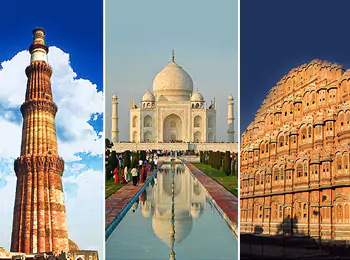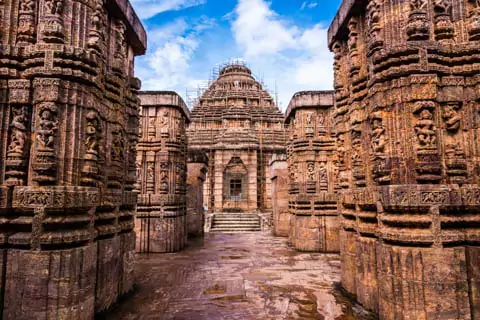India: Art
The account of Indian Arts and Handicrafts originates from one the most established human advancements of the world. The huge social and ethnic assorted variety has empowered an assortment of themes, strategies and specialties to thrive on this land. Conceived of hundreds of years old craftsmanship, the history shifts structures and themes that have intrigued the individuals the world over. Exceptional in their style mirrors the state of mind in Indian heritage. Expressions of the human experience and art of India are seen on the accompanying headings.
Wooden Art
Kashmir is the main state in India, where pecan trees develop. The specialists here make perplexing carvings on wood acquired from the pecan tree. Furniture things like tables, seats, stools, segments and so forth have rich botanical and trellis designs cut on them. Cutting done on pecan is either profound or shallow. Things like tables, natural product plate and bowls and so forth are additionally brightened with trim work. Wax finishing is done on completed items, with the goal that the excellence of the wood grain isn't lost. Rajasthan is known for articles and enhancing objects produced using privately got wood.
Every area of Rajasthan has its own remarkable wood convention. Barmer is notable for cut furnishings. Some furniture pieces like tables, low stools and so on… have smaller than expected compositions on them. Cut wood things, for example, cupboards, screens, seats, tables, almirahs, racks and so forth are profoundly elaborate. Rajasthan is likewise known for wood puppets looking like creatures, which are decorated with trim work. Dazzling jali or latticework is additionally created here. Specialists of Rajasthan likewise make gently cut figures of divinities on rosewood and sandalwood. Skilled workers from Madhya Pradesh utilize an assortment of wood like shisham, teak, dhudi, sal and kikar for making family unit things. Woodcraft from the innate belt of Bastar is known for figures of inborn divinities, cut wooden remembrances, covers and so forth. Madhya Pradesh is additionally renowned for painted and lacquered wood item, for example, toys, boxes, bedposts, supports posts, blossom containers and so on. Gwalior, Sheopur-Kalan, Rewa and Budhni are fundamental focuses of wood lacquering. Uttar Pradesh has many art communities occupied with making various things out of wood. Saharanpur is known for vine-leaf designs on Sheesham wood. Botanical, geometric and allegorical cutting is additionally done here with wood trim work. Decorate work is finished with bone and plastic as ivory is prohibited in India. Mainpuri is well known for woodwork on midnight or dark sheesham decorated with metal wire. Banaras is known for lacquered toys and smaller than usual utensils for kids to play with.
Diamonds & Jewellery
In early India, individuals formed adornments out of normal materials found in bounty everywhere throughout the nation seeds, plumes, leaves, berries, organic products, blossoms, creature bones, hooks and teeth. Indeed, even today such adornments are utilized by the diverse innate social orders. Unearthings at Mohenjodaro and different locales of the Indus Valley human progress have uncovered an abundance of trimmings. Apparently the two people of that time wore adornments made of gold, silver, copper, ivory and valuable and semi-valuable stones. The Ramayana and the Mahabharata are swarm with depictions of adornments and the code of Manu characterizes the obligations of the goldsmith. By the third century B.C., India was Gems and Jewelry the main exporter of gemstones, especially precious stones. Gold was generally brought into the nation, a training common in any event, during the Mughal time frame. In India the decorations are made essentially for all aspects of the body. Such an assortment of trimmings bears the declaration to the great aptitudes of the gem specialists in India. The scope of adornments in India differed from strict one to simply stylish one. Gems was created for people as well as for the divine beings, stately elephants and steeds. The specialty of gems was given a regal support directly from the antiquated occasions. The rajas and maharajas competed with one another to have the most impeccable and the most glorious bits of adornments. Sanctuary buildings bolstered various styles of gems scented sandalwood globule accessories, the petition dot or the rudraksh (berry of the elaocarpus canitrus) neckband, diverse silk and gold string pieces of jewelry. In the Hindu, Jain and Sikh people group where ladies don't acquire landed property, gems was a significant segment of the stree dhana (endowments given to a lady at the hour of her marriage). Gems, in light of its simple convertibility into money, were subsequently viewed as security and venture.
Paintings
Indians knew the art of painting since ancient time. The soonest artworks in India can be found on the walls of Bhimbetka collapses Madhya Pradesh. The dividers of these caverns have been brightened with creature and human figures. The Indian specialty of painting is differed and various, similar to the way of life, to which they have a place. Works of art are made utilizing an assortment of medium. Customary Indian artworks delineate divine beings and goddesses, fanciful scenes, scenes relating to past illustrious houses and scenes from day by day life.
Works of art made by specialists having a place with various innate social orders are energetic, representative and portray all parts of inborn life. The presentation of Persian styled miniatures by the Mughals, loaned another measurement to the specialty of painting in India.
Not exclusively were Mughal miniatures extraordinary perfect works of art, they likewise affected nearby small schools in Rajasthan, Punjab and Himachal Pradesh. Different scaled down schools prospered in Rajasthan, during the Mughal time and preceded significantly after it. A portion of the significant smaller than expected schools of that period were: Mewar, Marwar, Kishangarh, Dhunbar and Hadoti school. Each school had its own unmistakable style, which recognized it from the others. Court scenes, love scenes, chasing scenes, pictures of nearby divinities and legendary scenes, overwhelm these canvases. Painted geometric structures and images had additionally been found on ceramics things having a place with the Indus valley human progress. The high purpose of painting in the antiquated period can be found in the frescoes from Ajanta, which portrays the life and style of that period all things considered.
Textiles
The first artistic data about textiles in India can be found in the Rigveda, which indicates to weaving. The old Indian legends Ramayana and Mahabharat additionally talk about an assortment of textures of those occasions. The Ramayana alludes to the rich styles worn by the gentry on one hand and the basic garments worn by the average people and religious zealots. India has a various and rich material custom. The beginning of Indian materials can be followed to the Indus valley human advancement. The individuals of this development utilized hand crafted cotton for weaving their articles of clothing. Unearthings at Harappa and Mohen - jo-Daro, have uncovered family unit things like needles made of bone and shafts made of wood, abundantly recommending that natively constructed cotton was utilized to make articles of clothing. Sections of woven cotton have likewise been found from these locales. India had various exchange joins with the outside world and Indian materials were famous in the antiquated world. Indian silk was well known in Rome in the early hundreds of years of the Christian time. Crowds of parts of cotton material beginning from Gujarat have been found in the Egyptian tombs at Fostat, having a place with fifth century A.D. Cotton materials were likewise sent out to China during the primes of the silk course. Abundant proof on the antiquated materials of India can likewise be gotten from the different figures having a place with Mauryan and Gupta age just as from old Buddhist contents and paintings (Ajanta caverns). Legend has it that when Amrapali, a prostitute from the realm of Vaishali met Gautam Buddha, she wore a lavishly woven semi straightforward sari, which says a lot of the specialized accomplishment of the old Indian weaver.
Potterry
The development of Indian earthenware production started with the Harappan age and the craft of molding and heating dirt articles as stoneware, pottery and porcelain has suffered through the ages. While ceramics and stoneware are particularly utilitarian and frequently ornamental, porcelain and studio earthenware have a place with the domain of craftsmanship. With the exception of a couple of instances of Indian earthenware production, which have been created from a solitary form, its majority is totally hand-demonstrated, a custom persisted to the twentieth century. There is proof of ceramics making, both carefully assembled and wheel-tossed, from all over India. At Harappa and Mohenjodaro, earthenware has been uncovered demonstrating that potter's place was a serious significant one in the public arena. The art was very much progressed. Rectangular ovens for terminating the item were being used. Seals and grain and water compartments were made that were put to utilize adequately. The spot of the potter in the specialty custom of India is novel. India has in excess of a million potters. They are stunning bosses - people the same. Regardless of the hey tech that has attacked the Indian situation, it is farfetched on the off chance that it will ever obliterate the potter's natural innovativeness. Ideally, new ages will see the value of stoneware. Among the different media picked by man for communicating his bliss through craftsmanship, music or writing, the least difficult has been delicate and moldable dirt. Deft fingers shape the most excellent structure and articulation. Dirt is such an intriguing medium, that if a piece of it is given to a youngster, he instinctually makes things out of it. Ceramics is the proportion of a nation's progress. Being perhaps the most seasoned specialty, man has communicated his emotions and his style in earth. A bit of earthenware has a visual message in its shape and shading. It is the most exotic everything being equal. It isn't just to be taken a gander at, yet additionally to be dealt with cautiously. No big surprise then that ceramics has been known as the verse of painstaking work. In any case, it is the relationship of religion with this workmanship that has given it a more profound noteworthiness and another measurement as well.
Carpet
India offers a wide scope of floor covers that have advanced throughout the hundreds of years to suit an assortment of tastes, atmospheres and spending plans. The woolen and silk floor coverings are increasingly eminent contrasted with different materials, for example, cotton and a few vegetable strands, which are utilized for making alluring and essentially valuable mats and durries. In the beginning periods, the themes utilized in the Indian floor coverings were simply Persian. Afterward, different structures were presented from Afghanistan, Turkey, China, Morocco and France. Bit by bit, the heap cover industry was styled in Indian way and accepted its very own character. Every locale built up a particular style of rug weaving. In the hilly locales of India, from Ladakh through Darjeeling in West Bengal and Sikkim to Manipur, floor coverings are made of unadulterated fleece in gleaming hues. The dominating themes are those of the mythical beast, snow-lion and lotus.
Carpet Patterns are additionally taken from Buddhist iconography with dhawaja (flag), the kalash (water-vessel) and the twin fish being top picks. Rugs from these districts depend on methods that are as unmistakable as the themes. These are basically Central Asian in convention. For more than 2500 years the examples duplicated were those of blossoms arabesques and rhomboids with a periodic creature structure. The examples have never gotten outdated. A few themes have a significant importance: the circle means time everlasting, the crisscross water and light, the swastika obscurity and the tree bliss and goodness.
Stone Work
The stone-carving tradition in India is one of the most extravagant on the planet. Organizations of bricklayers and stone carvers have existed here since the seventh century B.C. The abilities were passed on as family legend from father to child, training predominant in certain pieces of the nation even today. The old style convention of stone cutting was firmly connected with engineering. Every single significant sanctuary of India-be it Puri, Konark, Khajuraho, Kailash Temple, or the Shore Temple at Mahabalipuram-represent the rich custom of Indian stone carvings. The geographically old place that is known for Rajasthan, wealthy in various types of hard shakes like rocks, marbles, quartzite, records, and other changeable rocks, has been a stone-carver's heaven. Directly from the medieval occasions, the prepared accessibility of great stone (the utilization of block was practically obscure) made it simple for the Rajasthani developer to build solid and lovely fortifications, castles, and sanctuaries. The figures found in the antiquated and medieval sanctuaries of Bharatpur, Baroli, Ramgarh, Nagda, Ajmer, Chittor, Mandore, Jaisalmer, Bikaner, and Udaipur praise the creative abilities of the Rajasthani stonecutters. Aside from sanctuary carvings, the stone carvers of Rajasthan are noted for their jali (latticework) carvings. Most antiquated palatial structures of Rajasthan sport jali deal with their entryways and windows. The jali screens, etched from both sandstone and marble, were much of the time utilized in the windows of the zenanas (ladies' quarters) empowering the ladies in purdah to see the occasions of the courts without being seen. The screens additionally offered security from the components while permitting the section of outside air through the unpredictable geometric examples. Rajasthan keeps on being one of significant focuses of stone cutting in the nation. The capital city Jaipur is the focal point of marble cutting in Rajasthan. Here one can see craftsmans making marble pictures of the gods just as household utensils, for example, bowls for crushing flavors and working batter. At Ajmer, Udaipur, Jodhpur and Bikaner, one goes over some fine instances of the perplexing jali work done on screens and boards of the regal palaces.
Plan your trip with Travel to India:
We are pioneer Indian trip specialists and travel partner in India offering culture, heritage tours with travel itineraries to explore Incredible India. Visit at our Travel itineraries on https://www.traveltoindia.org/to chalk out your visit plan or you may keep in touch with us by email or calling.















